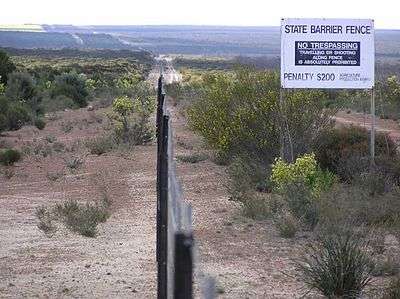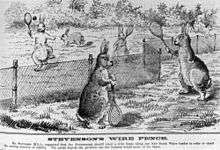Rabbit-proof fence

The State Barrier Fence of Western Australia,[1] formerly known as the Rabbit Proof Fence, the State Vermin Fence, and the Emu Fence, is a pest-exclusion fence constructed between 1901 and 1907 to keep rabbits and other agricultural pests, from the east, out of Western Australian pastoral areas.[2]
There are three fences in Western Australia: the original No. 1 Fence crosses the state from north to south, No. 2 Fence is smaller and further west, and No. 3 Fence is smaller still and runs east–west. The fences took six years to build. When completed in 1907, the rabbit-proof fence (including all three fences) stretched 2,023 miles (3,256 km). The cost to build the fences at the time was about £167 per mile ($250/km).[3]
When it was completed in 1907, the 1,139-mile (1,833 km) No. 1 Fence was the longest unbroken fence in the world.[4] It has been claimed that the fence is visible from space;[5] however, similar claims about the larger Great Wall of China have been debunked by NASA.[6]
History
Rabbits were first introduced to Australia by the First Fleet in 1788[7] and they become a problem when Thomas Austin released 24 wild rabbits for hunting purposes in October 1859, saying that "the introduction of a few rabbits could do little harm and might provide a touch of home, in addition to a spot of hunting."[8]
The rabbits were extremely prolific creatures and spread rapidly across the southern parts of the country. Australia had ideal conditions for a rabbit population explosion.
By 1887, losses from rabbit damage compelled the New South Wales Government to offer a £25,000 reward for "any method of success not previously known in the Colony for the effectual extermination of rabbits".[9] A Royal Commission was held to investigate the situation in 1901.
Construction
The fence posts are placed 12 ft (3.7 m) apart, and have a minimum diameter of 4 in (100 mm). There were initially three wires of 12½ gauge placed at 4 in (100 mm), 1 ft 8 in (0.51 m), and 3 ft (0.91 m) above ground, with a barbed wire added later at 3 ft 4 in (1.02 m) and a plain wire at 3 ft 7 in (1.09 m) to make the fence a barrier for dingoes and foxes as well. Wire netting was placed on this, which extended to 6 in (150 mm) below ground.
The fence was constructed with a variety of materials, according to the local climate and availability of wood. At first salmon gum and gimlet tree wood were used, although these attracted termites (locally known as white ants) and had to be replaced. Split white gum was one of the best types of wood used in the fence. Others used were mulga, wodjil, pine, and tea tree, based on what wood could be found close to where the fence was to be built. Iron was used in parts where there was no wood.
From 1901 the fence was constructed by private contractors, but in 1904 the project became the responsibility of the Public Works Department of Western Australia, under the supervision of Richard John Anketell.[3] With a workforce of 120 men, 350 camels, 210 horses and 41 donkeys, Anketell was responsible for the construction of the greater part of No. 1 Fence and the survey of its last 70 miles.[4]
Maintenance
Alexander Crawford took over the maintenance of the fence from Anketell as each section was finished and remained in charge until he retired in 1922.[4] The area inside the fence to the west became known as "Crawford's Paddock". The fence was maintained at first by boundary riders riding bicycles and later by riders astride camels. However, fence inspection was difficult from atop the tall animal. In 1910, a car was bought for fence inspection, but it was subject to punctured tyres. It was found the best way to inspect the fence was using buckboard buggies, pulled by two camels.
The camels were used as pack animals, especially in the north, while in the south, camels were used to pull drays with supplies for the riders. Camels were ideal for this as they could go for a long time without water, and it has been suggested that the fence could not have been built or maintained without the use of camels.
In addition to Crawford, there were four sub-inspectors, each responsible for about 500 miles (800 km) of fence, and 25 boundary riders who regularly patrolled 100-mile (160 km) sections of fence. Due to frontier violence in the north of the state, a 300-mile (480 km) section of No. 1 Fence was patrolled by riders in pairs.[10]
Crawford was responsible for eliminating rabbits which had breached the fence. In the first year following the fences' completion, rabbit colonies were found and destroyed at several locations inside the fence, including sites near Coorow, Mullewa, and Northampton.[10]
Following the introduction of myxomatosis to control rabbits in the 1950s, the importance of the rabbit-proof fence diminished.
Intersection with railway system
No. 1 Fence intersected the railway lines at:
- Eastern Railway near Burracoppin
- Wyalkatchem: Southern Cross railway at Campion
- Sandstone Branch Railway: just west of Anketell
- Meekatharra – Wiluna railway: at Paroo
No. 2 Fence intersected with most of the Wheatbelt railway lines of Western Australia.
Elsewhere in Australia

"Mr Stevenson, M.L.A., suggested that the Government should erect a wire fence along our New South Wales border in order to check the coming invasion of rabbits. The artist depicts the probable use the bunnies would make of the fence."
There is a rabbit-proof fence in Queensland.[11]
Cultural references
In 1929, Arthur Upfield, an Australian writer who had previously worked on the construction of No. 1 Fence, began writing a fictional story which involved a way of disposing of a body in the desert. Before the book was published, stockman Snowy Rowles, an acquaintance of the writer's, carried out at least two murders and disposed of the bodies using the method described in the book. The trial which followed in 1932 was one of the most sensational in the history of Western Australia. A book was published about the incident called Murder on the Rabbit Proof Fence: The Strange Case of Arthur Upfield and Snowy Rowles.[12] The incident is now referred to as The Murchison Murders.
Doris Pilkington Garimara's book, Follow the Rabbit-Proof Fence (1996), describes the use of the fence in the 1930s by three Indigenous Australian girls to guide their route back home to Jigalong. The girls, taken from their parents in Western Australia as part of the Stolen Generations, escaped from the Moore River Native Settlement where they were being held and walked back to their family at Jigalong by following the rabbit-proof fence. The dramatic film Rabbit-Proof Fence (2002) is based on the book. In 2016, Englishwoman Lindsey Cole walked the fence from Moore River Settlement, 1600km through to Jigalong. She was met by Doris's daughter at the end of the walk and completed the walk in September 2016.
See also
References
- Broomhall, F.H. (1991). The Longest Fence in the World. Hesperian Press. ISBN 0-85905-147-1.
- ↑ "Introduction". The State Barrier Fence of Western Australia, Centenary 1901–2001. National Library of Australia. Retrieved 28 July 2013.
- ↑ "State Barrier Fence overview". agric.wa.gov.au.
- 1 2 "History". The State Barrier Fence of Western Australia, Centenary 1901–2001. National Library of Australia. Retrieved 28 July 2013.
- 1 2 3 "The No. 1 Rabbit Proof Fence". Calamunnda Camels Pty Ltd. Retrieved 28 July 2013.
- ↑ "Controversy over WA's rabbit-proof fence plans". Australian Geographic. Retrieved 2016-03-22.
- ↑ "China's Wall Less Great in View from Space". NASA. Retrieved 2016-06-24.
- ↑ "The Mayor's Opening Address.". The Sydney Morning Herald. NSW: National Library of Australia. 28 November 1889. p. 7. Retrieved 22 January 2012.
- ↑ "The State Barrier Fence of Western Australia". Retrieved 30 May 2008.
- ↑ "Advertising. – Extermination of rabbits.". The Sydney Morning Herald. Sydney. 7 September 1887. p. 11. Retrieved 21 July 2012.
- 1 2 "Report on Rabbit Branch". The State Barrier Fence of Western Australia, Centenary 1901–2001. National Library of Australia. Retrieved 28 July 2013.
- ↑ "Darling Downs – Moreton Rabbit Board". ddmrb.org.au.
- ↑ Walker, Terry Walker. Murder on the Rabbit Proof Fence: The Strange Case of Arthur Upfield and Snowy Rowles. ISBN 978-0-85905-189-7.
External links
| Wikimedia Commons has media related to Rabbit-proof fence. |
- Run Rabbit Run!, Australian Museums and Galleries Online
- The State Barrier Fence of Western Australia, 1901–2001, National Library of Australia
- The Rabbit Proof Fence, Library of West Australian History
- At Australia’s Bunny Fence, Variable Cloudiness Prompts Climate Study, The New York Times